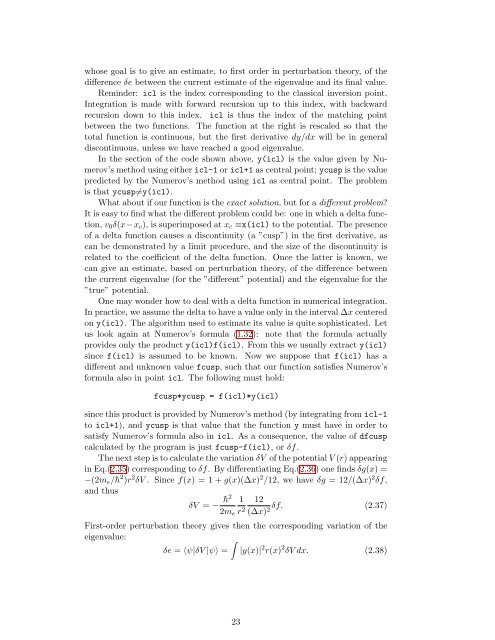Numerical Methods in Quantum Mechanics - Dipartimento di Fisica
Numerical Methods in Quantum Mechanics - Dipartimento di Fisica
Numerical Methods in Quantum Mechanics - Dipartimento di Fisica
Create successful ePaper yourself
Turn your PDF publications into a flip-book with our unique Google optimized e-Paper software.
whose goal is to give an estimate, to first order <strong>in</strong> perturbation theory, of the<br />
<strong>di</strong>fference δe between the current estimate of the eigenvalue and its f<strong>in</strong>al value.<br />
Rem<strong>in</strong>der: icl is the <strong>in</strong>dex correspond<strong>in</strong>g to the classical <strong>in</strong>version po<strong>in</strong>t.<br />
Integration is made with forward recursion up to this <strong>in</strong>dex, with backward<br />
recursion down to this <strong>in</strong>dex. icl is thus the <strong>in</strong>dex of the match<strong>in</strong>g po<strong>in</strong>t<br />
between the two functions. The function at the right is rescaled so that the<br />
total function is cont<strong>in</strong>uous, but the first derivative dy/dx will be <strong>in</strong> general<br />
<strong>di</strong>scont<strong>in</strong>uous, unless we have reached a good eigenvalue.<br />
In the section of the code shown above, y(icl) is the value given by Numerov’s<br />
method us<strong>in</strong>g either icl-1 or icl+1 as central po<strong>in</strong>t; ycusp is the value<br />
pre<strong>di</strong>cted by the Numerov’s method us<strong>in</strong>g icl as central po<strong>in</strong>t. The problem<br />
is that ycusp≠y(icl).<br />
What about if our function is the exact solution, but for a <strong>di</strong>fferent problem?<br />
It is easy to f<strong>in</strong>d what the <strong>di</strong>fferent problem could be: one <strong>in</strong> which a delta function,<br />
v 0 δ(x−x c ), is superimposed at x c ≡x(icl) to the potential. The presence<br />
of a delta function causes a <strong>di</strong>scont<strong>in</strong>uity (a ”cusp”) <strong>in</strong> the first derivative, as<br />
can be demonstrated by a limit procedure, and the size of the <strong>di</strong>scont<strong>in</strong>uity is<br />
related to the coefficient of the delta function. Once the latter is known, we<br />
can give an estimate, based on perturbation theory, of the <strong>di</strong>fference between<br />
the current eigenvalue (for the ”<strong>di</strong>fferent” potential) and the eigenvalue for the<br />
”true” potential.<br />
One may wonder how to deal with a delta function <strong>in</strong> numerical <strong>in</strong>tegration.<br />
In practice, we assume the delta to have a value only <strong>in</strong> the <strong>in</strong>terval ∆x centered<br />
on y(icl). The algorithm used to estimate its value is quite sophisticated. Let<br />
us look aga<strong>in</strong> at Numerov’s formula (1.32): note that the formula actually<br />
provides only the product y(icl)f(icl). From this we usually extract y(icl)<br />
s<strong>in</strong>ce f(icl) is assumed to be known. Now we suppose that f(icl) has a<br />
<strong>di</strong>fferent and unknown value fcusp, such that our function satisfies Numerov’s<br />
formula also <strong>in</strong> po<strong>in</strong>t icl. The follow<strong>in</strong>g must hold:<br />
fcusp*ycusp = f(icl)*y(icl)<br />
s<strong>in</strong>ce this product is provided by Numerov’s method (by <strong>in</strong>tegrat<strong>in</strong>g from icl-1<br />
to icl+1), and ycusp is that value that the function y must have <strong>in</strong> order to<br />
satisfy Numerov’s formula also <strong>in</strong> icl. As a consequence, the value of dfcusp<br />
calculated by the program is just fcusp-f(icl), or δf.<br />
The next step is to calculate the variation δV of the potential V (r) appear<strong>in</strong>g<br />
<strong>in</strong> Eq.(2.35) correspond<strong>in</strong>g to δf. By <strong>di</strong>fferentiat<strong>in</strong>g Eq.(2.36) one f<strong>in</strong>ds δg(x) =<br />
−(2m e /¯h 2 )r 2 δV . S<strong>in</strong>ce f(x) = 1 + g(x)(∆x) 2 /12, we have δg = 12/(∆x) 2 δf,<br />
and thus<br />
δV = − ¯h2 1 12<br />
2m e r 2 δf. (2.37)<br />
(∆x) 2<br />
First-order perturbation theory gives then the correspond<strong>in</strong>g variation of the<br />
eigenvalue:<br />
∫<br />
δe = 〈ψ|δV |ψ〉 = |y(x)| 2 r(x) 2 δV dx. (2.38)<br />
23
















